| Photojournal
- 28 October 2006
Misadventure
and discovery
|
On Saturday I headed
for my customary brunch with friends at the Golden Pita. While
we were there, the sun started to peek through the clouds, so
I decided to head off to do some photography afterwards. My destination
was the lower part of Hume Park, which runs along the Brunette
River at the north end of New Westminster.
I didn't quite make
it to the park; it turns out there was an accident on Columbia
Street right where the turnoff for the park is.
|
|
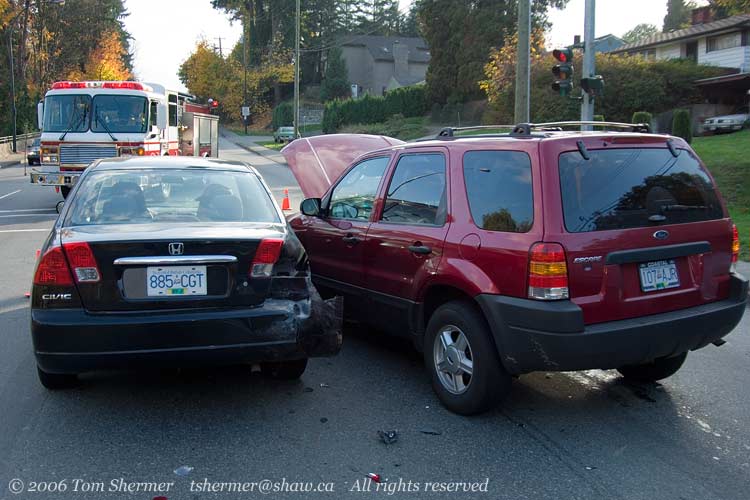 |
|
The accident involved
an SUV slamming into the back of my car as I was waiting for traffic
to clear so I could make my turn; the black car is mine.
I was pretty shaky
after my unexpected bumper-car ride, and so I sat on someone's
lawn on the side of the road while first the paramedics and then
police came and talked with me. A passing motorist must've called
the ambulance because they were there within five minutes and
neither I nor the other driver had called. The paramedic asked
me a few questions and thought I was relatively okay, but he offered
to take me to the hospital if I felt I should go. Presumably the
folks who were in the SUV got the same offer, but noone felt badly
enough to leave in the ambulance.
The police got our
accounts of the accident, and called for a tow truck to have both
cars towed off; the SUV had lost its transmission fluid and my
car was possibly operational but a bit mangled and liable to shed
pieces if driven. Here the firemen are disconnecting my battery
after having spread mulch around to absorb the fluid leaking from
the SUV.
|
|
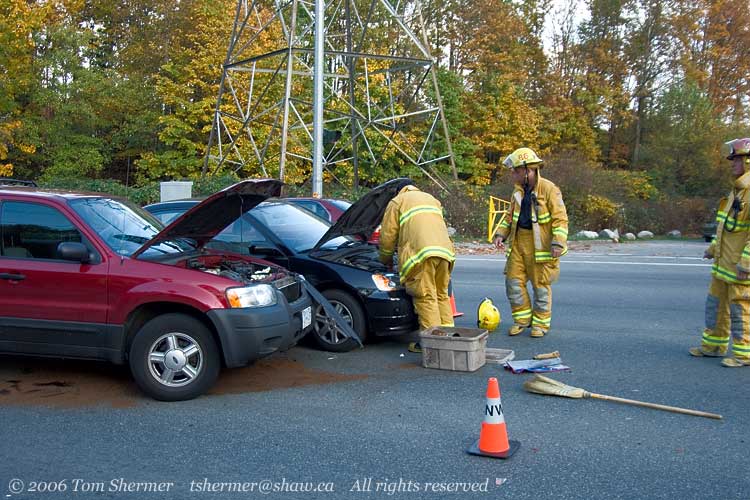 |
|
I managed to salvage
my camera gear and briefcase out of my trunk (which was still
operational, albeit stiffly so) before the constable called a
cab for me.
I guess I was still
quite shaky and the cab ride home was a bit of a blur.
One of the more interesting
aspects of taking so many photos is that my camera and I have
really gotten to know one another. My camera must've sensed that
I was out of it and so it decided to take some photos on the way
home; and furthermore it decided to take photos that show the
way I was feeling. I swear that I didn't press the shutter button
on the next three photos.
This one, as far as
I can tell, is a close-up on the back seat of the taxi, probably
taken as I was putting my camera and gear in. The blurry feel
captures my headspace pretty well.
|
|
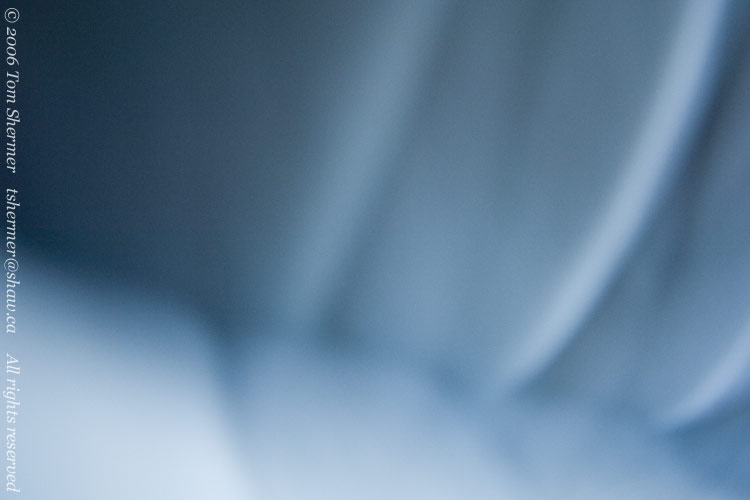 |
| In this
next one, I'm heading down the walkway beside my building, having
just gotten out of the cab. Everything is still a blur, and things
aren't quite standing up straight. |
|
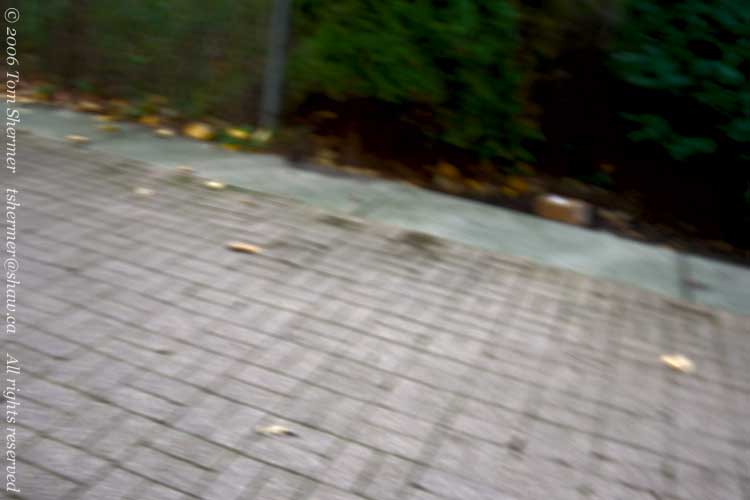 |
| Things continued
to be that way, but got a little more jangly, as I ducked into the
side entrance of my building. |
|
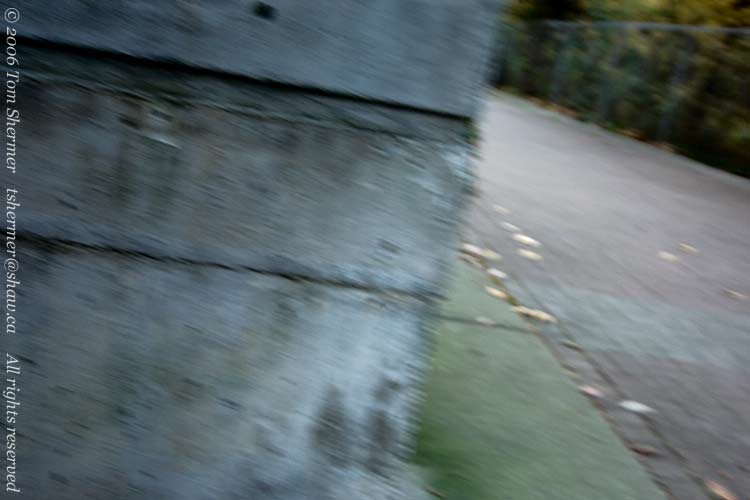 |
| Anyhow,
those three photos probably happened when something I was carrying
(like a backpack or a briefcase) accidentally hit the shutter button
on my camera. It was odd having the camera take pictures when it
wants to.
After that last one,
I was up the stairs, into my home, and able to relax a little.
I was sore in my lower back and neck; the lower back had been
that way since the impact, but the neck was a new development.
I consulted with my
friend Matthew, who is wise in the ways of insurance companies
and in the care of injuries resulting from accidents. He suggested
that I should make sure that I move around a bit, rather than
staying in one posture for a long time. So after I called in the
insurance claim, I decided that I should take a little walk to
keep things from stiffening up.
And if I'm going to
take a walk, I'm bringing my camera, dangit. So I put my macro
lens and macro lights on the camera, grabbed a plamp, and headed
out about half an hour before dusk. (A plamp is a gooseneck device
with clamps on both ends, used to clamp plants and other small
things into position.) This macro setup, without the tripod, is
fairly light, so I didn't think it would cause a strain on my
back. And bending around to get photos of little things would
probably be good, too: it exercises more mobility than simply
walking.
By this point, I was
feeling a lot more clear-headed than I had been earlier. My first
stop was in the courtyard, by one of our Japanese Maples. They're
all different shades of red now, and I wanted to try to capture
some of it up close. I got good color on this shot, but unfortunately,
my main leaf had a few blemishes that I didn't think about as
I was taking the shot.
|
|
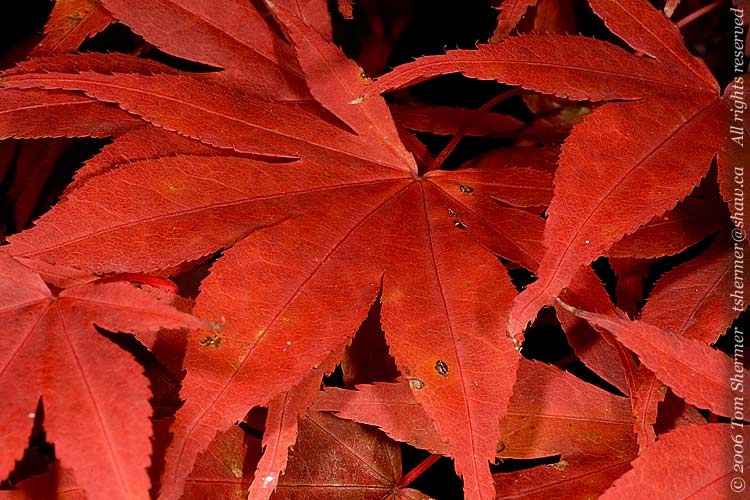 |
|
Next to the maple was
a rose bush, with the stems pruned back already. Some of the leaves
on this bush had some blemishes, and I did think about these ones.
The blemishes included holes, and I thought maybe something had
been eating at the leaves. Sometimes when this is the case, you
can find whatever was eating them under the leaves, so I checked
the undersides of a few leaves. On one of them, there was a small
yellowish sphere that was one or two millimeters across. I couldn't
make out what it was, but knew that I could probably get enough
detail to figure it out if I took a photo.
So I set up my plamp
to hold the leaf sideways and took a couple of shots of the little
yellow ball. It turns out that the little yellow thing was the
abdomen of a small spider. I asked around, and the best guess
is that this guy is a Cobweb Weaver, probably in the genus Theridion.
|
|
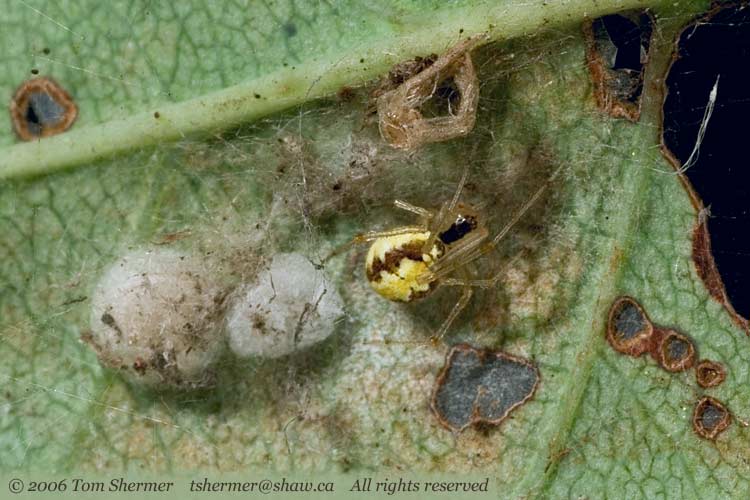 |
|
I've seen small spiders
before, but never one that colorful. That was pretty neat. And
it looks like there's a molted spider skin right above him, and
a couple of egg sacs behind him. So maybe there'll be more like
that one around soon.
On my way out of the
courtyard, I stopped to take a photo of one of our common local
Garden Spiders when I saw that the spider had prey. This spider
is at least ten times as long as the little yellow one.
|
|
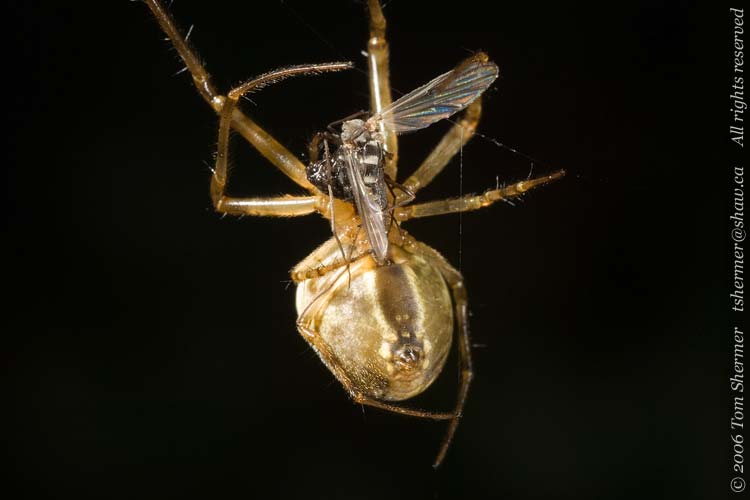 |
| I walked
down the quay as the sun set. I really didn't find much of anything
until well after dark, when I happened upon a large tropical-looking
plant with fronds that were up to about two meters long. (They were
taller than me.) I saw a little whitish bug on one of the fronds,
and so I engaged my plamp again and tooks some photos. |
|
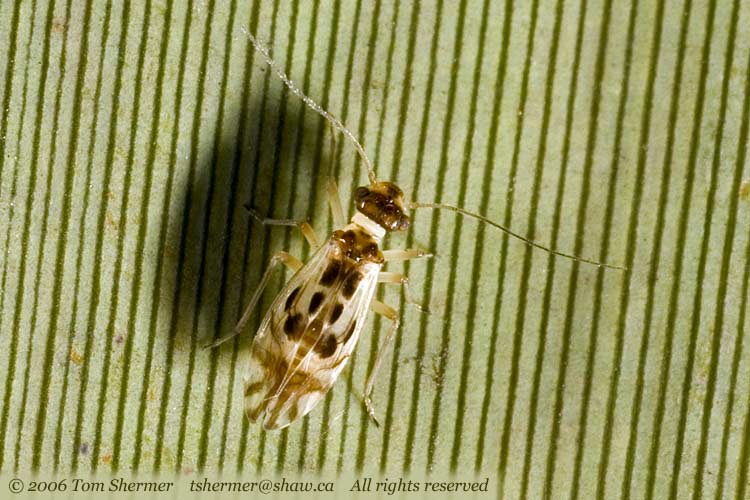 |
| That little
fellow was 4 to 6 millimeters long, and it turns out that he's some
sort of Bark Louse (Psocoptera). Bark lice aren't the lice
that like to ride on animals; these guys often live in the bark
of trees, and some of them make webs like spiders do. Here's more
of a side view of a different individual. There were several of
them on different fronds of the plant. |
|
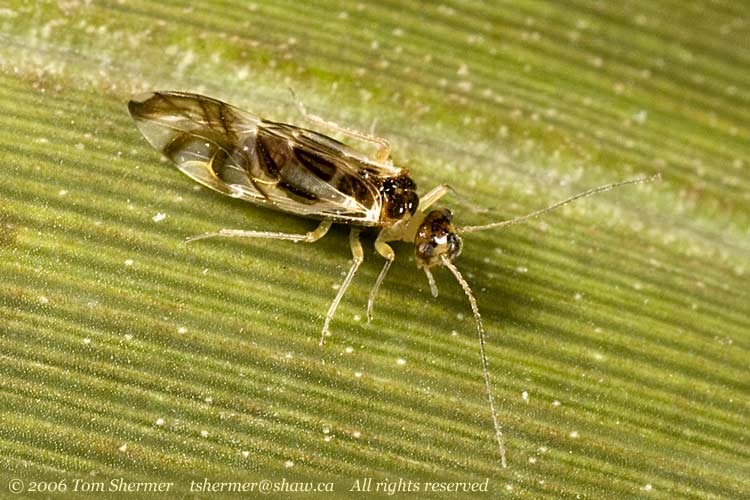 |
|
I really liked their
patterned wings.
At the edge of the
same frond as that last Bark Louse, I found a little spider. I've
never seen this kind of spider before, and I haven't had time
to figure out what kind it is.
|
|
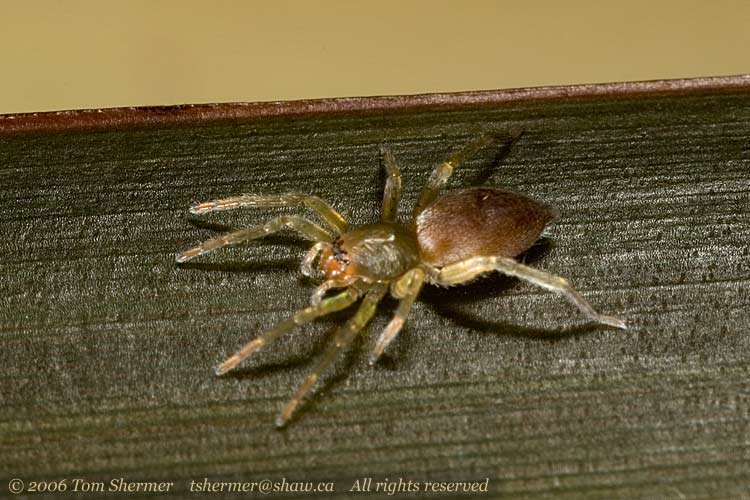 |
| And here's
another spider that I found a little later, on a rhododendron leaf.
There were several of these prowling around the rhodos. |
|
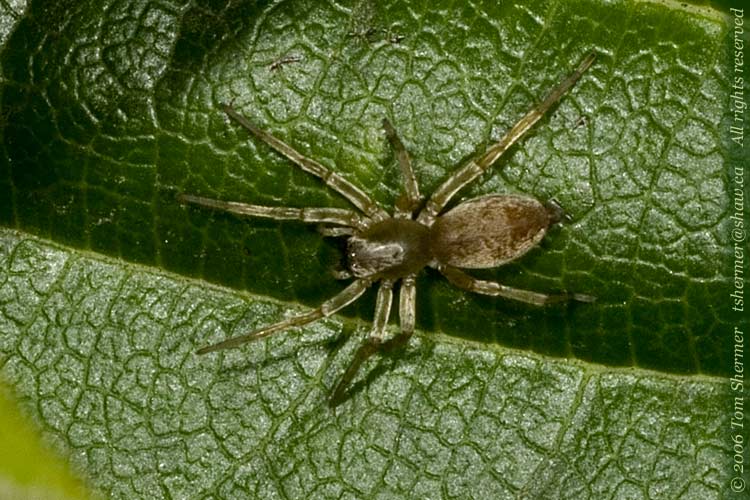 |
| On a patch
of low vegetation, in a place that was a little awkward to get my
camera to, I found this Broad-nosed Weevil (i.e. Weevil in the subfamily
Entiminae). I'd guess that he's in the genus Sitona;
he's a bit unusual in that he appears to have no bristles on his
body. A lot of weevils like this are very bristly. |
|
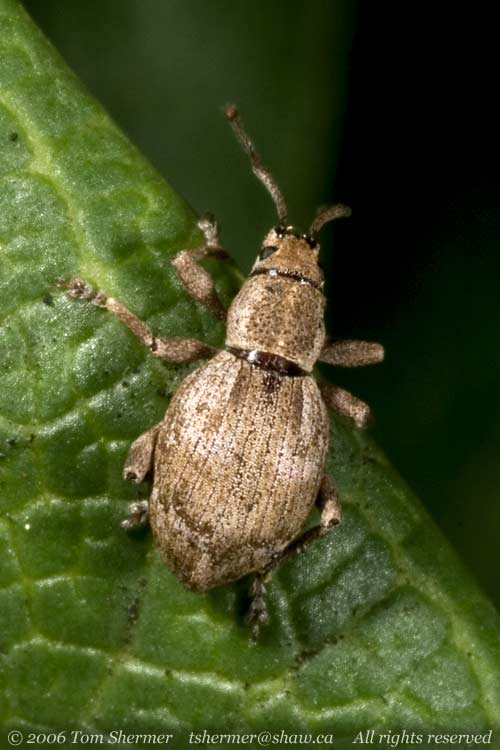 |
| Nearby,
I found another nocturnal spider. |
|
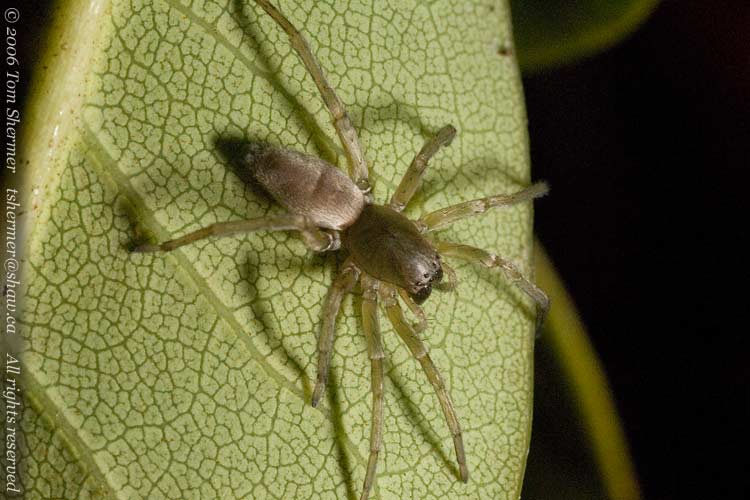 |
| My last
interesting finds were in a little patch of succulent plants. It
started when I noticed this little fellow. In this photo, he's maybe
four or five millimeters long. When he stretched out to move in
a straight line, he was maybe eight. To my naked eye (in the dim
light from the streetlamp) he was dark brown or black, but the flash
revealed some translucency and dark speckling. |
|
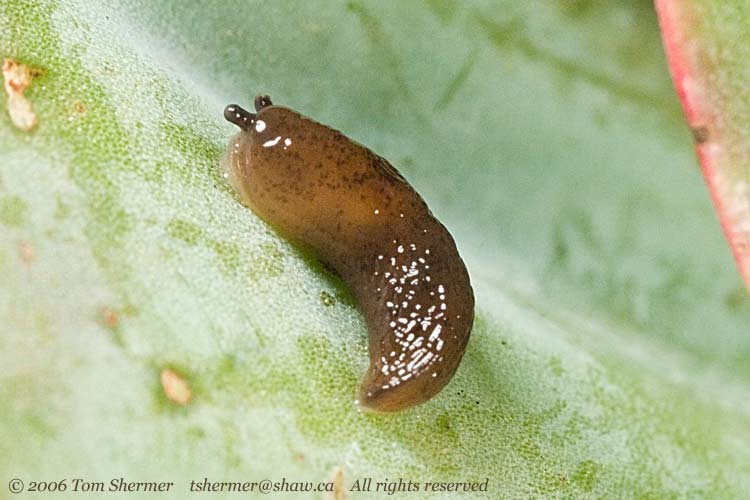 |
| I measured
the slug by taking some photos of him by a penny. As I was doing
this, I noticed a much bigger slug some 10 to 20 centimeters over.
This guy was easily twice or thrice the length of the previous one;
he's huge. |
|
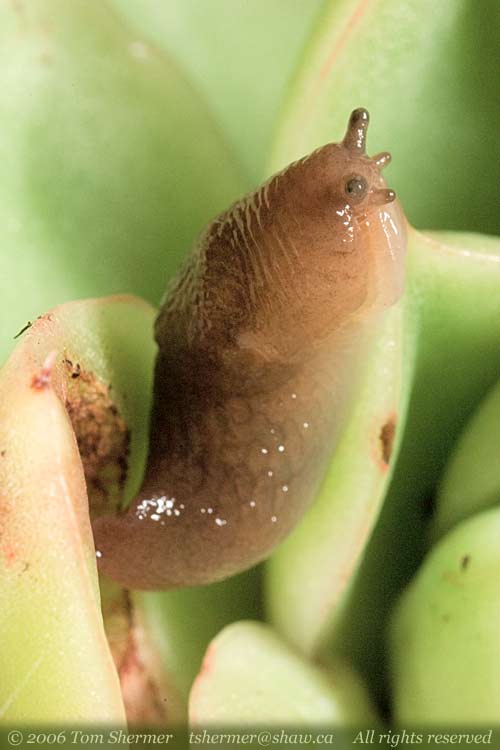 |
| And here's
another shot of that slug, this time he's all stretched out. Now
you can see just how huge huge really is. |
|
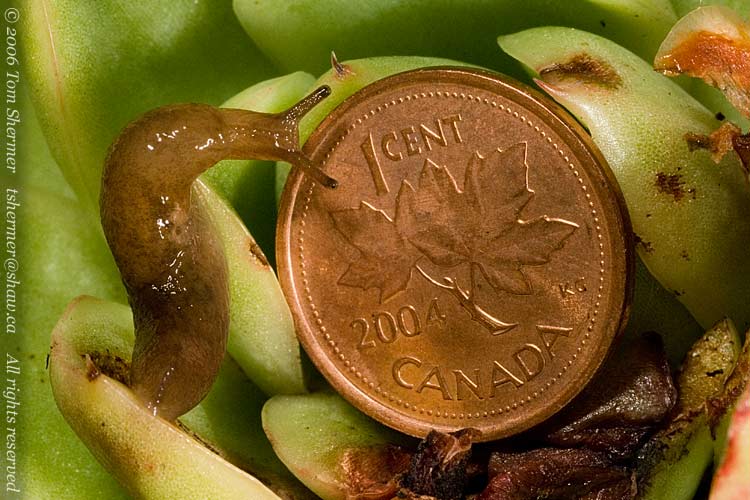 |
|
Canadian pennies, for
those of you with no access to them, are about 19 millimeters
in diameter.
The slugs were a great
find; I'm always happy to find new critters. I did some digging
in my mollusc book and found two candidate species for my slugs:
Deroceras laeve (Meadow Slug) and Deroceras panormitanum
(Longneck Fieldslug). I'd guess from the size of the big one that
they're Longnecks; which are supposed to be 25 to 30 millimeters
long. Meadow Slugs are supposed to have an upper limit of around
25 mm. However, that's cutting it pretty close, and the book says
that the best way to tell these two apart is to examine some of
their internal organs...which I'm not really inclined to do.
That was it for my
walk down the quay; I had accomplished my main goal of keeping
my back moving, and I'd discovered a lot of interesting new things
along the way. Not a bad ending to a day that didn't seem to be
going all that well.
Slightly banged up,
Tom
|
|
|